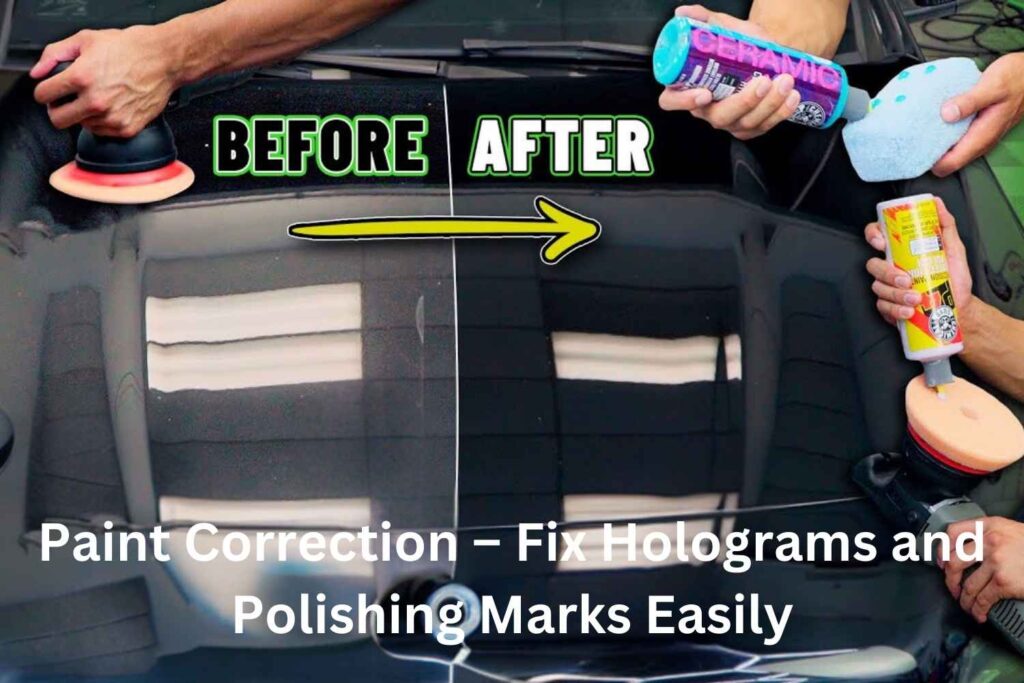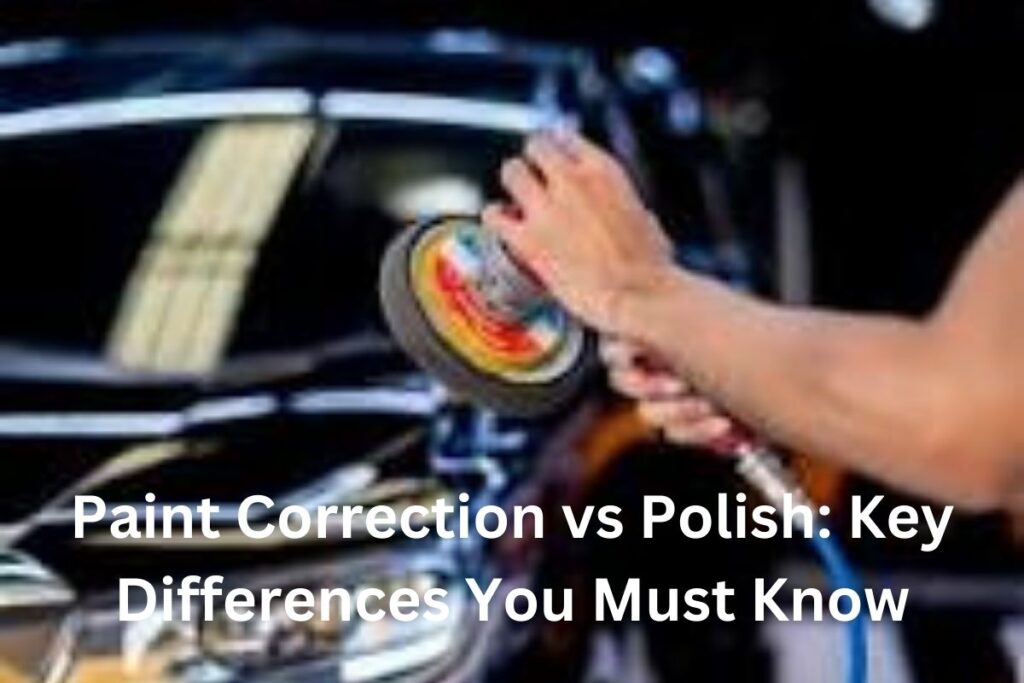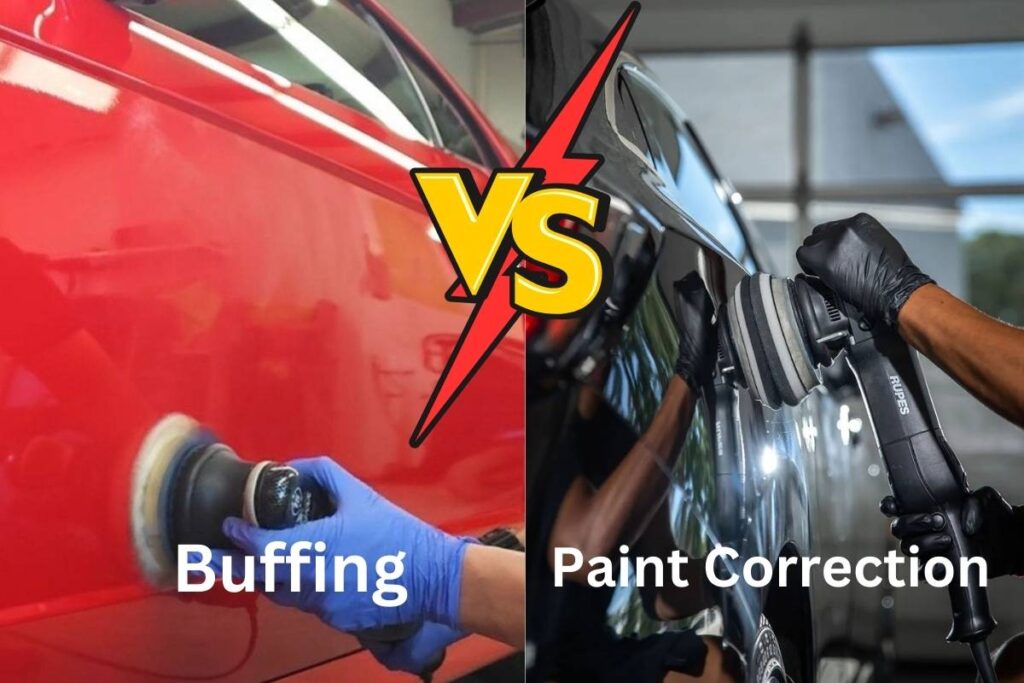Ever wondered which method is better for restoring your car’s shine—hand polish or machine polish? Both techniques promise to fix scratches, remove swirl marks, and bring back the glossy finish of your car. But they work in very different ways and have unique strengths.
Hand polishing offers control and precision for smaller tasks, while machine polishing delivers speed and power for larger jobs. So, how do you decide which one is right for your car?
This blog post will break down the differences between hand polish vs machine polish. You’ll learn the pros, cons, and ideal uses of each method. By the end, you’ll have the knowledge to make the best choice for your car’s paint correction needs. Stay tuned for everything you need to know!
Table of Contents
ToggleHand Polishing for Paint Correction

Hand polishing uses simple tools. A soft applicator pad and polish are the main items. You apply the polish to the pad and rub it onto the paint using your hand. Small circular motions work best.
This method takes time. It works well for small areas or light scratches. You can control the pressure better with your hands. This makes it safer for delicate parts of the car, like edges or tight corners.
Hand polishing is cheaper. You only need a few items. There’s no need to buy expensive machines. This makes it a good choice for beginners or those on a budget.
It has some limits. Fixing deep scratches or covering large areas is hard. Your arms may get tired quickly. The results depend on how much effort you put in. Machines can achieve faster and more even results in such cases.
Hand polishing works best for light scratches or areas a machine can’t reach. It’s a simple and safe method for minor paint correction.
Machine Polishing for Paint Correction

Machine polishing uses a powered tool. These machines have a rotating or vibrating pad. The pad spreads polish across the car’s surface. This method works faster and gives better results on large areas.
There are two main types of polishers. Dual-action polishers move in two ways. The pad rotates and vibrates. This makes them safer for beginners. Rotary polishers spin in one direction. They work faster but need more skill to avoid damage.
Machine polishing removes deep scratches and heavy imperfections. It evens out the paint and clears oxidation quickly. This method saves time compared to hand polishing. It also provides a smoother and shinier finish.
There are some downsides. Machines cost more. Beginners may need practice to avoid damaging the paint. The tool can also miss tight spaces, where hand polishing might be better.
Machine polishing is ideal for fixing serious paint damage. It works best on large surfaces and delivers professional results.
Key Differences Between Hand and Machine Polishing
Hand Polish vs Machine Polish: A Comparison
Hand polish vs machine polish methods have clear differences. Each works best for specific tasks. Understanding these differences helps you decide the right method for your car.
Hand polishing takes more time and effort. It suits small areas or light scratches. You control the pressure directly. This makes it safer for edges, curves, and tight spots. It is also affordable. You only need a pad and polish. This makes it a good option for beginners or quick fixes.
Machine polishing works faster. It handles large areas and deep imperfections with ease. The finish looks smoother and more professional. It removes scratches, swirl marks, and oxidation effectively. Machines save time, but they cost more. Beginners need to practice to avoid paint damage. Machines also struggle with narrow spaces.
The choice depends on your car’s needs. Small scratches or quick touch-ups are easier with hand polishing. Large surfaces or deep damage are better suited for machines. Both methods have strengths and weaknesses. Knowing these makes it easier to decide the best option.
Effectiveness of Hand Polish vs Machine Polish
Hand polish vs machine polish methods offer different levels of effectiveness. Hand polishing works well for minor paint issues. Light scratches and small swirl marks can often be removed by hand. It is also good for areas like corners or trims, where machines cannot reach easily.
Machine polishing is more powerful. It removes deep scratches and heavy oxidation faster. The rotating or vibrating pads provide consistent pressure, which leads to a smoother finish. Machines also cover large surfaces more quickly than hand polishing.
The results depend on the condition of the paint. Hand polishing might not remove deep imperfections or heavy swirl marks. Machines handle those problems better. If the paint has severe damage or dullness, machine polishing will likely give better results.
For small touch-ups, hand polishing can be enough. For a full paint correction, machines are often the better choice. The right option depends on the task and your skill level. Both methods have their place in maintaining your car’s paint.
Time and Effort: Hand Polish vs Machine Polish
Hand polish vs machine polish methods differ in the time and effort they require. Hand polishing takes longer. It depends on manual effort. You use small circular motions, which can be tiring, especially on larger areas. It requires patience and physical work to achieve good results.
Machine polishing works much faster. The motorized tool covers more surface in less time. It reduces the physical effort needed. Even large areas can be polished in a short period. This makes it ideal for full paint corrections or heavily damaged paint.
For small fixes or specific spots, hand polishing is enough. It is also useful for people who prefer a hands-on approach. Machine polishing is better for larger jobs or those who want quick results with less effort.
Both methods have their advantages. The choice depends on how much time and energy you are willing to spend. Each approach works best for different situations.
Cost Comparison: Hand Polish vs Machine Polish
Hand polish vs machine polish methods also differ in cost. Hand polishing is less expensive. You only need basic items like a polishing pad and a bottle of polish. These tools are easy to find and affordable. This makes hand polishing a good choice for beginners or those on a budget.
Machine polishing costs more upfront. A good polisher can be expensive. You will also need polishing pads and compounds designed for machines. These tools can add up over time. Regular maintenance of the machine might also increase costs.
Despite the higher price, machines save time and provide better results for large areas. Professionals often use machine polishers because they work faster and deliver a high-quality finish. Hand polishing may take longer, but it is more affordable for small touch-ups.
The cost depends on the job. Fixing small scratches with hand polishing can be cheap and effective. Large-scale paint correction may justify the higher expense of a machine. Both methods offer value in the right situations. Let me know when to continue with the next section!
Suitability for Different Paint Conditions: Hand Polish vs Machine Polish
Hand polish vs machine polish methods work best on different types of paint problems. Hand polishing is better for light scratches or minor swirl marks. It works well for touch-ups and small areas. This method is also safer for delicate parts of the car, like edges and corners.
Machine polishing handles more serious damage. Deep scratches, heavy swirl marks, and oxidation require the power of a machine. The rotating or vibrating pads provide consistent pressure, which removes imperfections more effectively. Machine polishing is ideal for large areas that need uniform results.
Older cars with sensitive or thin paint might benefit from hand polishing. It allows more control and reduces the risk of damage. Newer cars with harder clear coats may need machine polishing to fix deeper imperfections.
Understanding the condition of the paint is important. Hand polishing suits small jobs and light damage. Machine polishing is better for restoring heavily damaged or dull paint. Both methods have specific strengths for different situations. Let me know when you’re ready for the next section!
Safety Considerations: Hand Polish vs Machine Polish

Safety matters in both methods. Hand polish vs machine polish techniques carry different risks. Hand polishing is safer for beginners. You control the pressure with your hand. This lowers the chance of damaging the paint. It is also less likely to overheat the surface, which can cause paint burns.
Machine polishing requires more care. The power of the tool can harm the paint if not used properly. Applying too much pressure or holding the pad in one spot for too long can remove too much clear coat. This might leave visible marks or damage the paint layer.
Machines also create heat during use. If not handled carefully, this heat can harm the paint or underlying layers. Using the correct speed and pad type is essential for safe results.
Proper tools and techniques help avoid damage in both methods. Hand polishing is safer for light work or beginners. Machine polishing works well for serious paint correction but needs skill and attention. Always follow best practices to protect the car’s finish.
Choosing the Right Method: Hand Polish vs Machine Polish
Hand polish vs machine polish methods depend on your needs. The right choice comes down to the condition of your car, your skill level, and your budget. Both methods work, but one may suit your situation better.
Hand polishing is better for light work. Small scratches, minor swirl marks, or delicate areas are ideal for this method. It is also cheaper and easier to start. A polishing pad and compound are enough to get good results. Beginners feel more confident with this method since it offers more control and less risk.
Machine polishing is the better option for deep scratches or large areas. Machines save time and give a smoother, more even finish. The initial cost is higher, but the results justify the expense for major paint correction. This method works best for experienced users or those willing to learn.
Think about your car’s needs. Fixing a few small spots? Hand polishing is a simple and safe choice. Restoring a dull or heavily scratched car? Machine polishing will deliver faster and better results. Both methods are valuable tools for maintaining a car’s shine.
Final Thoughts on Hand Polish vs Machine Polish
Hand polish vs machine polish methods offer unique benefits. Both can improve your car’s paint and restore its shine. The right choice depends on the type of work needed and your personal preferences.
Hand polishing is a simple and cost-effective option. It is best for small touch-ups and light scratches. This method is safe and easy for beginners. It also allows precision in tight or delicate areas.
Machine polishing delivers professional results. It handles deep scratches and heavy damage with ease. This method works faster and is ideal for large areas. While it requires practice and a higher budget, the finish is often smoother and more consistent.
Your car’s condition plays a big role in deciding the method. For quick fixes and minor imperfections, hand polishing works well. For restoring dull or heavily damaged paint, machine polishing is the better choice. Both methods are effective tools for keeping your car looking its best.
Frequently Asked Questions (FAQs)
Can I polish my car by hand?
Yes, you can polish your car by hand. Hand polishing works well for small scratches and light swirl marks. It is safe and cost-effective. However, it may not be as effective for deep scratches or large areas.
Is machine polishing safe for my car’s paint?
Machine polishing is safe when done correctly. It removes deep scratches and heavy oxidation effectively. But improper use can damage the paint. It’s important to use the right equipment and techniques.
How often should I polish my car?
Polishing your car 1-2 times a year is usually enough. Over-polishing can thin the paint. Regular washing and waxing help maintain the shine between polishing sessions.
Do I need special training to use a machine polisher?
Basic training or practice is helpful. Understanding the tool and techniques reduces the risk of paint damage. Many resources are available to learn proper machine polishing methods.
Which method is better for an older car?
Hand polishing is gentler and safer for older cars with delicate paint. It allows more control and reduces the risk of damage. Machine polishing can be too aggressive for aged paint.







